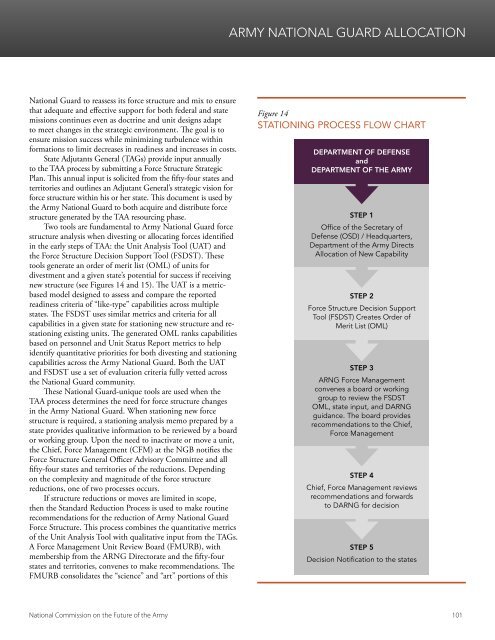THE FUTURE OF THE ARMY
Futurearmy
Futurearmy
Create successful ePaper yourself
Turn your PDF publications into a flip-book with our unique Google optimized e-Paper software.
<strong>ARMY</strong> NATIONAL GUARD ALLOCATION<br />
National Guard to reassess its force structure and mix to ensure<br />
that adequate and effective support for both federal and state<br />
missions continues even as doctrine and unit designs adapt<br />
to meet changes in the strategic environment. The goal is to<br />
ensure mission success while minimizing turbulence within<br />
formations to limit decreases in readiness and increases in costs.<br />
State Adjutants General (TAGs) provide input annually<br />
to the TAA process by submitting a Force Structure Strategic<br />
Plan. This annual input is solicited from the fifty-four states and<br />
territories and outlines an Adjutant General’s strategic vision for<br />
force structure within his or her state. This document is used by<br />
the Army National Guard to both acquire and distribute force<br />
structure generated by the TAA resourcing phase.<br />
Two tools are fundamental to Army National Guard force<br />
structure analysis when divesting or allocating forces identified<br />
in the early steps of TAA: the Unit Analysis Tool (UAT) and<br />
the Force Structure Decision Support Tool (FSDST). These<br />
tools generate an order of merit list (OML) of units for<br />
divestment and a given state’s potential for success if receiving<br />
new structure (see Figures 14 and 15). The UAT is a metricbased<br />
model designed to assess and compare the reported<br />
readiness criteria of “like-type” capabilities across multiple<br />
states. The FSDST uses similar metrics and criteria for all<br />
capabilities in a given state for stationing new structure and restationing<br />
existing units. The generated OML ranks capabilities<br />
based on personnel and Unit Status Report metrics to help<br />
identify quantitative priorities for both divesting and stationing<br />
capabilities across the Army National Guard. Both the UAT<br />
and FSDST use a set of evaluation criteria fully vetted across<br />
the National Guard community.<br />
These National Guard-unique tools are used when the<br />
TAA process determines the need for force structure changes<br />
in the Army National Guard. When stationing new force<br />
structure is required, a stationing analysis memo prepared by a<br />
state provides qualitative information to be reviewed by a board<br />
or working group. Upon the need to inactivate or move a unit,<br />
the Chief, Force Management (CFM) at the NGB notifies the<br />
Force Structure General Officer Advisory Committee and all<br />
fifty-four states and territories of the reductions. Depending<br />
on the complexity and magnitude of the force structure<br />
reductions, one of two processes occurs.<br />
If structure reductions or moves are limited in scope,<br />
then the Standard Reduction Process is used to make routine<br />
recommendations for the reduction of Army National Guard<br />
Force Structure. This process combines the quantitative metrics<br />
of the Unit Analysis Tool with qualitative input from the TAGs.<br />
A Force Management Unit Review Board (FMURB), with<br />
membership from the ARNG Directorate and the fifty-four<br />
states and territories, convenes to make recommendations. The<br />
FMURB consolidates the “science” and “art” portions of this<br />
Figure 14<br />
STATIONING PROCESS FLOW CHART<br />
DEPARTMENT <strong>OF</strong> DEFENSE<br />
and<br />
DEPARTMENT <strong>OF</strong> <strong>THE</strong> <strong>ARMY</strong><br />
STEP 1<br />
Office of the Secretary of<br />
Defense (OSD) / Headquarters,<br />
Department of the Army Directs<br />
Allocation of New Capability<br />
STEP 2<br />
Force Structure Decision Support<br />
Tool (FSDST) Creates Order of<br />
Merit List (OML)<br />
STEP 3<br />
ARNG Force Management<br />
convenes a board or working<br />
group to review the FSDST<br />
OML, state input, and DARNG<br />
guidance. The board provides<br />
recommendations to the Chief,<br />
Force Management<br />
STEP 4<br />
Chief, Force Management reviews<br />
recommendations and forwards<br />
to DARNG for decision<br />
STEP 5<br />
Decision Notification to the states<br />
National Commission on the Future of the Army 101


